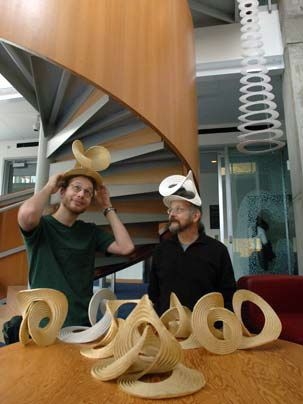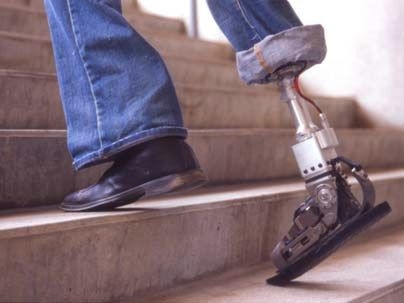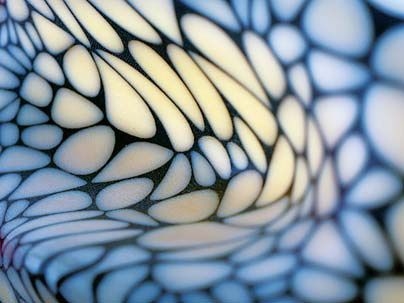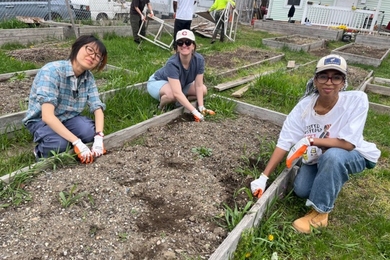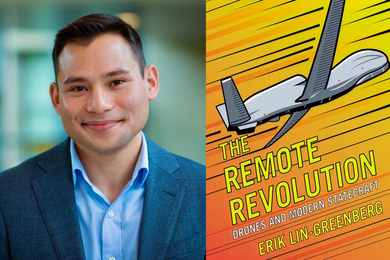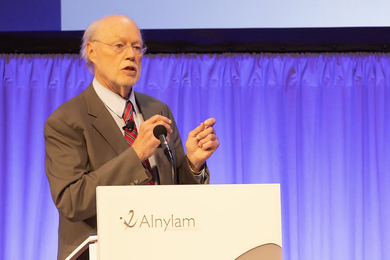MIT artists, designers and architects are filling some of New York's most prominent and competitive exhibition spaces this year with works that disrupt traditional distinctions among art, technology and performance.
Right now, four groups of MIT designers have works on exhibit at the prestigious Museum of Modern Art. A fifth will exhibit there this summer. The Whitney Biennial, renowned for distilling the best of the global cutting-edge best in art, includes works by two MIT affiliates. The list goes on, with one-person MIT shows in smaller venues.
It all adds up to a new, dramatic presence on the global arts stage for MIT. Long a leader in applying technology to the world's problems, MIT artists and designers are devising new genres, setting new standards for the way video, digital and other technologies foster innovations in the arts.
"Some of the most important things happen at the intersection of art, design and technology, and MIT is where it all comes together," says Adele Naude Santos, dean of the School of Architecture and Planning. "Now we're on the world stage, with faculty showing their work in many countries. And it's not just art for art's sake. Like everyone else at MIT, our artists and designers are working on the critical social issues of our times."
Two upcoming MIT exhibits in New York plumb such critical issues as housing and lending--one, a multimedia installation called "Red Lines," will show at the Institute next fall. Recently, MIT faculty in visual arts, music and theater have received critical acclaim for bold works that blend technology with traditional arts practice to explore social or political issues.
"Ten years ago, the words 'art' and 'technology' meant two very different--if not opposite--things. That is certainly not the case today," says Professor Mark Jarzombek, associate dean of the School of Architecture and Planning.
"At MIT, numerous scientists, engineers, students, architects, and artists are working in the complex interface between art and technology. This is one of the prime growth areas of research, both in physical and conceptual terms, for the coming decade," he adds.
MIT may indeed be benefiting from a sharper focus on technology by leading art institutions, but Lori Gross, director of arts initiatives and adviser to the associate provost, notes that art has traditionally played a central role over the years in fostering risk-taking and problem-solving at MIT.
"The arts at MIT encourage the crossing of traditional boundaries to invent new fields of research and to create the skills and media needed to serve society and its future challenges," she says.
MIT takes Manhattan
The Museum of Modern Art's current exhibit, "Design and the Elastic Mind," features origami, architecture and design by MIT faculty and graduate students. The show runs through May 12.
Part of the exhibit is New York Talk Exchange, a project by Carlo Ratti and his colleagues in the MIT Media Lab's senseable city lab, illustrates the volumes of long distance telephone and IP (Internet Protocol) data flowing between New York and cities around the world.
"It is like showing how the heart of New York connects with the global network of cities," said Ratti, director of the senseable city lab and associate professor of the practice of urban technologies. The network looks like delicate fireworks. To see, go to http://senseable.mit.edu/nyte.
MoMA commissioned Neri Oxman, graduate student in architecture and planning, to design four pieces for "Design and the Elastic Mind."
Oxman's research uses advanced digital applications in architectural and design practices. Some of Oxman's images look like weirdly stretched animal skins; others, like slinky vases.
Hugh Herr, associate professor in media arts and sciences, presents a prototype of his ankle-foot prosthesis, in "Design and the Elastic Mind."
Composed of titanium, aluminum, carbon composite and polyeurethane and manufactured by iWalk, Inc., the ankle was designed by Herr and the MIT Media Lab's Biomechatronix Group, including Jeff Weber, research engineer, and Bruce Deffenbaugh, technical associate
The MoMA design exhibit also features three curved origami sculptures by MIT's pioneering origami team, Erik Demaine, Esther and Harold E. Edgerton Associate Professor of electrical engineering and computer science, and Martin Demaine, Angelika and Barton Weller Artist-in-Residence in electrical engineering and computer science.
The Demaine works, titled "Computational Origami," are made of elephant hide paper and look like double-mobius strips, or small, mad free-form freeways.
Larry Sass, assistant professor of architecture, is one of five architects commissioned by MoMA to construct pre-fabricated homes in a vacant lot on 53rd street, next to the Museum for its summer exhibit, "Home Delivery: Fabricating the Modern Dwelling," starting in July.
Sass' design is based on a re-interpretation of New Orleans' "shotgun" houses-narrow, one-floor structures-using recycled plywood and friction-fit components, all put together with rubber mallets.
The Whitney Biennial, held at the Whitney Museum of American Art through June 1, ranks among the international art world's most renowned exhibitions. Curators scour the world for cutting-edge works in all media.
This year, two affiliates from the Center for Advanced Visual Studies (CAVS) represent MIT at the Biennial:
David Reinfurt, web, identity and publications designer for CAVS and a CAVS research affiliate, participates in the Biennial as a member of Dexter Sinister, a graphic design partnership and publishing workshop that prints books in very limited, "just-in-time" runs for occasional sale at their store.
Joe Zane, CAVS artistic production coordinator, worked with Michael Smith, 2005-2006 CAVS fellow, in producing the video, "Portal Excursion," a segment of Smith's 30-year work, "Mike's World." Fictional Mike, a hapless Everyman, is the subject of video, installation and performance works on display at the Biennial.
More upcoming MIT shows:
Damon Rich, former CAVS fellow and founder and creative director of The Center for Urban Pedagogy, presented "Red Lines, Death Vows, Foreclosures, and Risk Structures" at the New York Architecture League on Jan. 17.
"Red Lines" is a multimedia installation of photography, models, digital animation, and video, that explores where the money for building and repairing buildings comes from, the social history of home finance and what leads to the abandonment of buildings. It goes on view at the MIT Museum's Compton Gallery in September 2008.
Marisa Jahn, visiting artist in the Media Lab's Tangible Media Group, will present "Commuter Cookout," a project with Steve Shada, at the ISE Cultural Foundation in New York, on March 7.
"Commuter Cookout" is a cookbook and stainless steel cooking set that enables urban commuters to cook from the heat of auto engines. Driving times determine the menu -- from cooking eggs (short hop to the dry cleaner) to preparing a long stew (ride to Logan Airport).
Antonio Muntadas, visiting professor of art in the visual arts program, has one-person show at the Kent Gallery in Chelsea opening on May 1. He's preparing the 7th installment of his project, "Political Advertisement Project 1952 - 2008," to coincide with this year's election.
Muntadas and Marshall Reese have been aggregating found footage of election campaigns since 1984; their work has been showcased every four years in such New York venues as Artist Space, NYPL and Lincoln Center.
A version of this article appeared in MIT Tech Talk on March 19, 2008 (download PDF).
